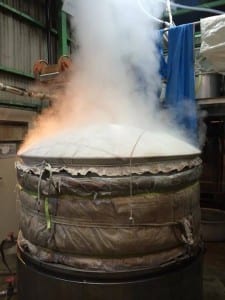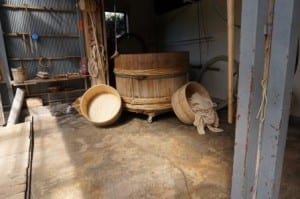 It was well into the evening when the phone rang, but my caller i.d. told me the call was from the cell phone of the owner and presidente-for life of a kura with which I work closely. Since he fits into both the friend and business associate categories, I happily answered.
It was well into the evening when the phone rang, but my caller i.d. told me the call was from the cell phone of the owner and presidente-for life of a kura with which I work closely. Since he fits into both the friend and business associate categories, I happily answered.
He began the conversation with the Japanese-language equivalent of, “Du-hu-hu-hu-de. I’m pretty ha-a-a-a-mmered.” Not your typical call from the owner of a prestigious sake brewery, to say the least.
And to what do I owe this honor? Surely there must be a reason you have called at this hour and in this, er, state?
“Indeed, indeed. Today was ‘kaizo.’ It’s over. We are done for this season. That’s it. Owari! All we have to do is clean up and we are so outta here until the fall.” He seemed to momentarily forget he lived in the old house attached to the kura. “And, thanks to your support,” he continued with typical Japanese uber-humility, “we managed to finish the brewing season this year without any major difficulties.” I was fairly sure I had nothing to do with that, and of course politely deferred.
“Wow,” I responded. “That’s great. Congratulations. Another season down! I am sure you are relieved, and I am just as sure your sake will be great again this year.”
“Hold on. There is someone here that wants to talk to you.” The cell
phone got dropped at least twice and bashed into something made of glass on its way to whomever it was destined. Things like that happen in a room full of happy, buzzed sake brewers. Actually, I knew who it was going to be before I even heard the familiar voice.
“Du-hu-hu-hu-de. I’m pretty hammered too-hu-hu-hu.” It was the relatively young toji (master brewer). “We made it through yet another season. And thanks to your support, we finished without a hitch.” Yeah, yeah.
The true reason behind their call, driven though it was by the unbridled exuberance of the evening’s “kaizo” celebration, party, was to thank me for a positive assessment of a new sake they came out with that I was fortunate enough to have been able to taste several days earlier. I had coincidentally ran into the two of them, armed with a bottle, at a sake pub the night before a big Tokyo tasting. Regardless, it was great fun to hear from them, and congratulate them on completing the season.
~ ~ ~ ~ ~ ~ ~
As many readers certainly recall, sake brewing runs roughly from the fall It all starts when this is harvested
until the spring. Just when a kura begins to brew sake and when they finish for the year depends on a number of factors, including of course how much they brew. On top of this, dynamics including the number of people actively working in the brewery, the number of tanks, size of the batches, how old or new their equipment is, and how often they start a batch will all combine to determine just when they start and end. But typically it runs from mid-October to mid-April.
As the season draws to a close, there are two significant days that the people in the brewery owners and brewers together will celebrate. One is called “koshiki-daoshi,” the other is “kaizou.”
 “Koshiki-taoshi” refers to overturning the rice-steaming vat. The koshiki is the large vat in which rice is steamed every morning or so. Traditionally these were wooden, but rarely does one see that anymore. Most are steel these days, and in fact, many are fully automatic. Long ago, when the last vat of rice had been steamed, the koshiki would be turned on to its side, cleaned thoroughly, and left to dry and be put into storage until the next brewing season begins the next fall.
“Koshiki-taoshi” refers to overturning the rice-steaming vat. The koshiki is the large vat in which rice is steamed every morning or so. Traditionally these were wooden, but rarely does one see that anymore. Most are steel these days, and in fact, many are fully automatic. Long ago, when the last vat of rice had been steamed, the koshiki would be turned on to its side, cleaned thoroughly, and left to dry and be put into storage until the next brewing season begins the next fall.
When the last batch of rice has been steamed for the year, and the koshiki has been knocked over for that final thorough cleaning, the brewers can see the light at the end of the brewing-season’s tunnel. Hence the the celebratory nature of the day.
Of course, that last day’s vat of rice will then be put into the last tank that is still fermenting, and after that there are still three weeks or more of waiting for that tank, and others still bubbling along, to finish fermenting, and then be pressed, filtered, pasteurized and sent to mature for a while. So even after koshiki-daoshi their work is far from done. Still, they know they are getting close to the end of six months or more of long, hard days.
“Kaizo,” on the other hand, is written with characters that mean “all (has been) made,” and naturally enough indicates the day on which the last tank has been completely finished, and therefore all the sake for the year has been brewed. All there is left to do is to sweep up, tidy up, and pack up.
 After koshiki-daoshi, typically, the brewers and other employees of a sake brewery will often have a little bash in or nearby the kura. A nice dinner, warm toasts to each other, and plenty of sake. While, from what I have heard, it is more common to have this little party after koshiki-taoshi, obviously the folks at some places – such as those that called me in the story above – wait until kaizo, when presumably they can sleep late the next day.
After koshiki-daoshi, typically, the brewers and other employees of a sake brewery will often have a little bash in or nearby the kura. A nice dinner, warm toasts to each other, and plenty of sake. While, from what I have heard, it is more common to have this little party after koshiki-taoshi, obviously the folks at some places – such as those that called me in the story above – wait until kaizo, when presumably they can sleep late the next day.
Much has changed in the sake-brewing society, and while long ago the entire brewing staff lived in the brewery for the whole brewing season, which was six months or longer. Today, however, many (if not most) brewing personnel live close to the kura and commute. The significance of koshiki-daoshi and kaizo must have been much greater back then.
Nevertheless, both koshiki-daoshi and kaizo are culturally and historically important milestones in each kura’s brewing season.




